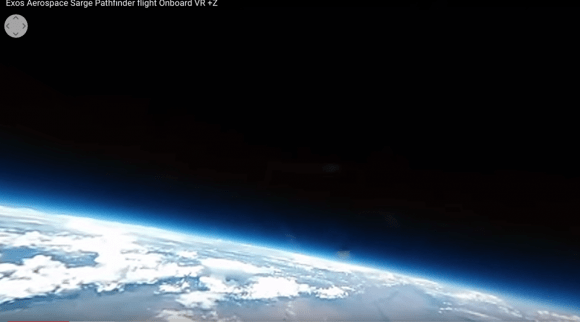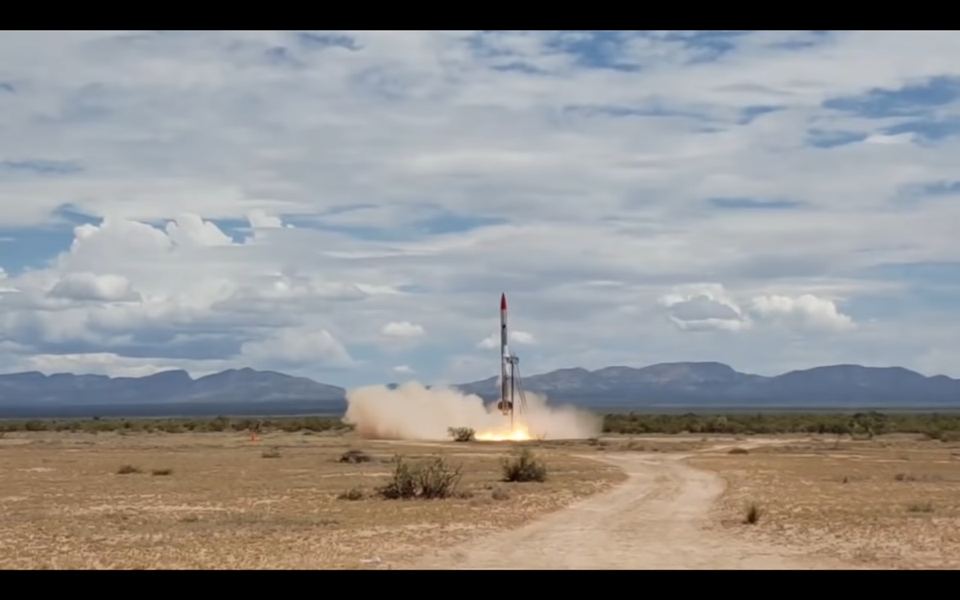One of the defining characteristics of the renewed age of space exploration is the way that private aerospace companies are participating like never before. In addition to major companies like SpaceX, Blue Origin and United Launch Alliance, there are countless companies that are looking to reduce the costs of individual missions and provide launch services to the public and private sector.
One such company is EXOS Aerospace Systems & Technologies, Inc., a leading developer of reusable space launch vehicles. This past summer, the company conducted a Pathfinder test flight with their Suborbital Autonomous Rocket with GuidancE (SARGE) rocket. The successful launch and recovery has validated the SARGE platform and was a major step towards EXOS’s long term plans to send small packages into orbit using reusable rockets.
The test flight took place at 2:15 pm (EST) on August 25th, 2018, from Spaceport America in the New Mexico desert. After reaching its peak altitude of 28 km (17 mi), the rocket parachuted back to Earth about 15 minutes later and landed a short distance from the pad. The crew then recovered the spent rocket, which had suffered damage to only sacrificial components. This test therefore also validated the rocket’s reusability, as well as the capability of the autonomous control system and preflight integration process.
For the test launch, the SARGE rocket carried nine payloads, which included a 3D printed cube containing a number of student experiments provided by Enterprise in Space (EIS) – a non-profit organization and the world’s first NewSpace education program. The items – which were provided by a group of middle-school students from St. Louis – included gel pens, pencils, gum, post-it notes, and small zipper bags with popcorn kernels, jalapeno seeds, sugar maple tree seeds, crayon shavings and vials of body lotion and sunscreen.
The purpose of this and other payloads was to determine how they will fair during launch and in a microgravity environment. This is one of the main purposes of the SARGE rocket, which is to provide an inexpensive testing platform for companies, schools and space agencies. Basically, the rocket will let customers see if their payloads will handle the stresses of a space launch prior to sending them into orbit or to rendezvous with the International Space Station (ISS).
Other payloads included memorabilia and collectibles provided by ASTRAX International (a Japan-based space tourism company), two science packages from Purdue University, memorabilia provided by Johnny Ireland and Brenda Ferdinando (two cancer survivors), the dog tags for a round 1 investor, a heat transfer experiment (Arete) provided by students from the Greater Nanticoke Area, a large collection of scientific monitors built and provided by Space Kidz India, and a Mayo Space Medicine technology test bed developed by the Mayo Clinic and Oxehealth and provided with the help of the Center for Applied Space Technology (CAST) – who are also partnered with Enterprise in Space.
The launch, as well as the pre-launch setup and recovery of the rocket, were also captured by a live-stream webcast. As John Quinn, the chief operations officer for EXOS, was quoted as saying in a Spaceport America press statement:
“We are excited to announce the successful test of our SARGE platform at Spaceport America, and even more excited to know that the risk mitigation phase that supports our goal of building a reusable first stage orbital platform is at a culmination point. The SARGE platform will now receive its final flight modifications, and start to provide data critical to building a reliable reusable (first stage) LEO launcher.”
Dan Hicks, the CEO of Spaceport America, also expressed enthusiasm for the test launch, saying:
“It was great to host the successful test launch of the EXOS SARGE vehicle at Spaceport America. EXOS has checked-off another milestone on their path to develop a reusable LEO launcher. This successful Pathfinder flight test brings them one step closer to regular commercial suborbital launches. We look forward to their next flight, and to working with them to achieve their longer term goals at Spaceport America.”
This flight was the latest in a long line of successful tests for the EXOS SARGE platform, which is the test bed for the company’s proposed orbital launcher. Essentially, the software and technologies developed and tested with SARGE will be used to create the reusable first stage of JAGUAR. This rocket, once operational, will be used to send small and micro satellites to Low Earth Orbit (LEO) to see how they fair during launch and in a microgravity environment.
With Sarge, EXOS will be able to provide frequent opportunities to test satellites that weight up to 50 kg (110 lbs) in space for 3-4 minutes, and then return them to the launch site just 20 min after launch. Based on the company’s expectations, the JAGUAR rocket will allow EXOS to send payloads of between 100 and 200 kg (220 – 440 lbs) to a maximum altitude of 200-400 km (124 to 248 mi).
It is also hoped that this rocket will allow EXOS to conduct payload and cargo deliveries to the International Space Station (ISS), which orbits Earth at an altitude of 340 km (211 mi). At present, EXOS is contracted to provide suborbital services for NASA, but hopes to expand this role to include an indefinite-delivery, indefinite-quantity (IDIQ) onramp with the agency.

According to Quinn, both SARGE and JAGUAR will use a modified version of NASA’s Morpheus flight code, which the company acquired through a Space Act Agreement. “Since our SARGE rocket is designed for reusability, it is proving to be an excellent risk mitigation platform for our orbital technology development program and helping to drive space access costs down,” Quinn indicated in a pre-launch press statement.
The launch also came after a series of tests, which included a successful tie down test that took place on August 17th, 2017, and a hover test that was conducted on March 17th, 2018. These tests have helped EXOS to validate both the hardware and software of the SARGE rocket, which included its Guidance, Navigation and Control systems (GNC).
In the future, it is clear that a significant amount of space exploration and ventures will be conducted by private aerospace companies. More and more, commercial providers are offering launch services to customers ranging from government agencies and telecommunication companies to scientific institutions and universities. With this increasing volume comes increasing opportunity for the public to get involved.
At this rate, a day will be coming soon where student experiments, space tourists, and crowdfunded telescopes will become a regular feature of near-earth space. Beyond that? Well, let’s just say that the sky shall no longer be the limit!
Disclaimer: I a member of Enterprise in Space’s Social Media and Outreach Team and volunteer as a technical writer for them.
Further Reading: EXOS Aerospace, Spaceport America, Enterprise in Space

